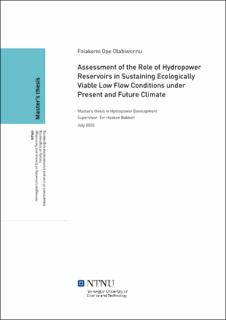| dc.description.abstract | Usually, low flow in rivers occur as a result of an extended period of dryness which is likely attributed to drought. Due to drought being a natural occurrence as an outcome of reduction in precipitation in a region for a long time, reservoirs can be used to mitigate negative effects on the supply of water in dry periods and also supply water for other purposes besides its primary purpose, which in Norway is hydropower production. Unfortunately, due to climate change across the world such as in the mountainous regions of Norway, low flow occurs in rivers during summer. This is mainly a consequence of increased evaporation and reduced precipitation. Also, in the winter period, low flow is prevalent due to precipitation being stored as snow which irrespective of increased periods of melting, hydropower production causes reduced flow. Hence, controlling the water level using reservoirs cause direct and indirect impacts in the flow regime of rivers just as regulation releases might make flows higher than it would have been naturally. River Glomma in southern Norway was therefore chosen as a case study to examine the effect of regulation on the ecosystem and how regulation releases might make flows higher than it would have been naturally and consequently sustain low flow condition. Subsequently, two unregulated basins in the river Glomma was equally chosen to evaluate the effect of climate change on the low flow condition of the river without regulation. Thereafter, meteorological data and flow data were used to calibrate hydrological model on Water Evaluation and Planning System (WEAP) so as to observe the effect of regulation on this river. Results from this thesis provide insight on the effect of climate change on low flow conditions with and without the regulation. Additionally, findings suggest that the effect of reservoir storage on low flow during critical periods in both winter and summer should be assessed and recommendations can be made to policy makers on planning strategies into how water is released downstream so as to sustain low flow condition, thus providing recommendations to companies to determine when to increase released water during the periods of low flow. | |
